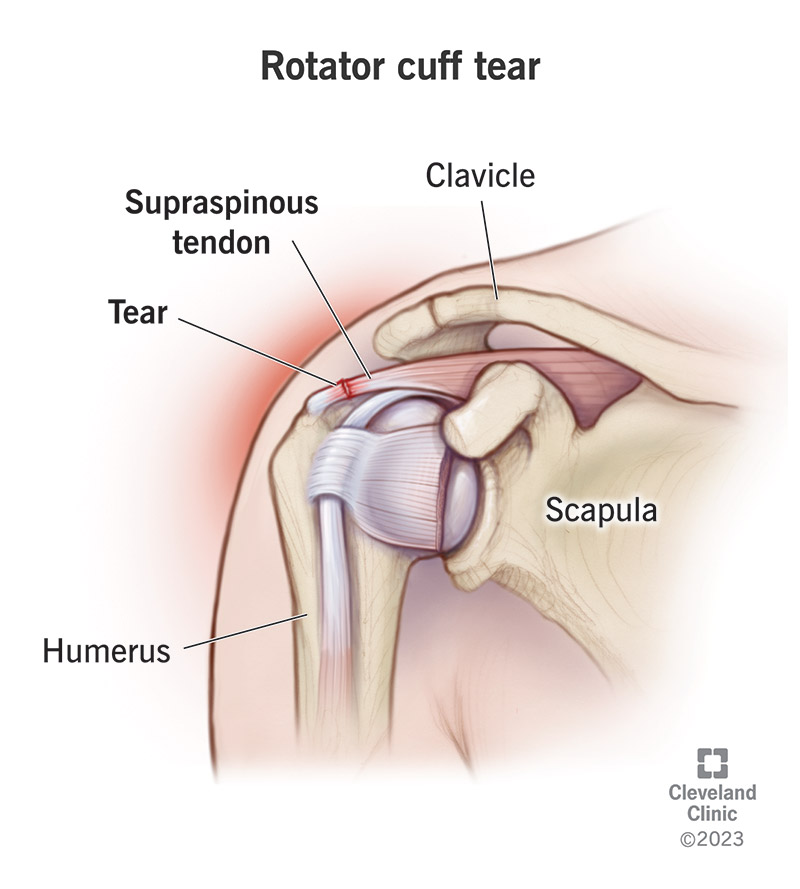To determine the type of shoulder injury you have, consult with a healthcare professional. Seek expert advice for an accurate diagnosis.
Injuries to the shoulder can cause pain and limit movement, making it important to identify the specific type of injury. A healthcare professional, such as a doctor or physical therapist, can conduct a thorough examination and potentially order diagnostic tests like X-rays or MRI scans.
They will assess your symptoms, medical history, and may ask you to perform certain movements or tests to evaluate the shoulder. Some common types of shoulder injuries include rotator cuff tears, dislocations, or separations, labral tears, and shoulder impingement. Early diagnosis can lead to appropriate treatment and better outcomes.
Common Types Of Shoulder Injuries
When it comes to shoulder injuries, it's essential to understand the different types in order to determine the appropriate treatment and rehabilitation plan. Here are the most common types of shoulder injuries:
Rotator Cuff Tear
A rotator cuff tear refers to a tear in one or more of the tendons of the rotator cuff muscles. The rotator cuff is a group of muscles and tendons that surround the shoulder joint, providing stability and allowing a wide range of motion.
Rotator cuff tears can be caused by repetitive overhead motions, trauma, or degenerative conditions. Symptoms include pain, weakness, limited range of motion, and difficulty performing daily activities. Treatment usually involves physical therapy, anti-inflammatory medications, and in severe cases, surgery to repair the torn tendons.
Labral Tear
A labral tear is an injury to the labrum, which is a ring of cartilage that surrounds the shoulder socket. This injury is common in athletes who participate in sports that involve repetitive overhead motions or sudden traumatic dislocations. Symptoms include shoulder instability, clicking or popping sounds, limited range of motion, and pain with certain movements. Treatment may involve physical therapy, medication to manage pain and inflammation, and sometimes surgery to repair or remove the torn labrum.
Shoulder Impingement
Shoulder impingement occurs when the space between the rotator cuff tendons and the acromion (a bony prominence on the shoulder blade) narrows, causing the tendons to get pinched or irritated.
This condition is often seen in individuals who perform repetitive overhead activities or have poor posture. Symptoms include pain, weakness, difficulty reaching overhead, and a clicking sensation. Treatment usually involves resting the shoulder, physical therapy to strengthen the surrounding muscles, and anti-inflammatory medications.
Shoulder Dislocation
A shoulder dislocation happens when the ball-shaped head of the upper arm bone (humerus) comes out of the shoulder socket. This can occur from a traumatic event or as a result of repetitive motions that gradually loosen the joint.
Symptoms include severe pain, swelling, inability to move the arm, and visible deformity. Treatment often involves relocation of the joint, immobilization with a sling or brace, physical therapy, and sometimes surgery to repair damaged tissues or stabilizing the joint.
In conclusion, recognizing the specific type of shoulder injury is crucial for accurate diagnosis and appropriate treatment. Whether it's a rotator cuff tear, labral tear, shoulder impingement, or shoulder dislocation, prompt medical attention and a tailored rehabilitation plan can help restore shoulder function and alleviate pain.

Credit: my.clevelandclinic.org
Symptoms Of Shoulder Injuries
Upon experiencing discomfort in your shoulder, it's crucial to pay attention to the symptoms as they can provide important clues about the type of injury you may have sustained. It's essential to understand the common symptoms of shoulder injuries, such as pain and swelling, limited range of motion, weakness, and instability. Familiarizing yourself with these symptoms can help you identify the specific issues you may be facing and seek appropriate medical attention. Let's delve into these symptoms in more detail:
Pain And Swelling
Pain and swelling are prevalent symptoms of a shoulder injury. If you notice excessive pain accompanied by swelling in your shoulder area, it may indicate an underlying issue that requires attention. These symptoms can be indicative of various conditions, including tendonitis, bursitis, or even a rotator cuff injury.
Limited Range Of Motion
Another common symptom of a shoulder injury is limited range of motion. If you find yourself struggling to perform daily tasks such as reaching for objects or lifting, or if you experience discomfort when attempting to move your shoulder in certain directions, it could signal a potential shoulder injury. Decreased flexibility and restricted movement are key indicators that there may be an issue affecting the shoulder joint.
Weakness
Weakness in the shoulder area is another noteworthy symptom to be mindful of. If you notice a decrease in strength or find it challenging to perform activities that previously posed no difficulty, it could be a sign of an underlying shoulder injury. Weakness in the shoulder can manifest in tasks such as lifting, carrying objects, or even performing simple exercises.
Instability
Shoulder instability is a significant indication of a shoulder injury. If you perceive a sense of instability or a feeling that your shoulder may give way, it could be an indication of an underlying issue with the muscles, tendons, or ligaments supporting the shoulder joint. This sensation of instability may become more pronounced during specific movements or activities.
Diagnostic Methods For Shoulder Injuries
When it comes to diagnosing shoulder injuries, healthcare professionals rely on various diagnostic methods to determine the exact type and severity of the injury. These methods help in guiding the appropriate treatment plan to promote effective recovery.
Understanding these diagnostic methods can help you gain insight into your shoulder injury, providing you with the necessary information to make informed decisions regarding your healthcare. In this article, we will explore the three main diagnostic methods used for shoulder injuries: physical examination, imaging tests (x-rays and MRI), and arthroscopy.
Physical Examination
A physical examination is the first step healthcare professionals undertake when assessing a shoulder injury. During a physical examination, the doctor or specialist examines your shoulder for any signs of tenderness, swelling, or deformity. They may also check for your range of motion and test your strength by asking you to perform specific movements.
The physical examination may involve different techniques that target specific structures within the shoulder joint. For instance, the doctor may perform specific tests to assess the stability of the shoulder joint or evaluate the integrity of the rotator cuff muscles. These tests can help the doctor identify the possible cause of your shoulder pain or dysfunction.
Imaging Tests (x-rays, Mri)
Imaging tests play a crucial role in diagnosing shoulder injuries, as they provide an inside view of the affected area. X-rays are often the first imaging test ordered for shoulder injuries as they can visualize bone fractures, dislocations, or signs of degenerative conditions like arthritis. X-rays are quick and painless, involving minimal exposure to radiation.
However, when it comes to evaluating soft tissues like tendons, ligaments, or the labrum, additional imaging tests such as a magnetic resonance imaging (MRI) scan may be necessary. An MRI can offer more detailed images of the soft tissues, giving healthcare professionals a better understanding of the underlying shoulder injury. This can also help in ruling out other potential causes of shoulder pain or dysfunction.
Arthroscopy
Arthroscopy is a minimally invasive surgical procedure used for both diagnosis and treatment of various shoulder conditions. It involves inserting a small camera called an arthroscope into the shoulder joint through small incisions. The camera allows the doctor to visualize the inside of the joint and assess the structures directly.
Arthroscopy provides valuable information about the condition of the joint, including the extent of damage, the presence of any tears or inflammation, and the overall health of the tissues. If necessary, the doctor can also perform corrective procedures during the arthroscopic surgery, such as removing loose fragments, repairing damaged tissues, or stabilizing the joint.
In conclusion, the diagnostic methods for shoulder injuries encompass a combination of physical examination, imaging tests like x-rays and MRIs, and arthroscopy. Each method provides valuable information that aids in determining the type and severity of the shoulder injury.
Collaborating with healthcare professionals and understanding these diagnostic techniques can help you effectively manage your shoulder injury and embark on a journey towards a full recovery.

Credit: www.stoneclinic.com
Treatment Options For Shoulder Injuries
Shoulder injuries can be painful and debilitating, making it essential to explore the various treatment options available. Depending on the severity and nature of your shoulder injury, there are three primary treatment approaches: conservative approaches, medications, and surgical interventions.
Conservative Approaches (rest, Physical Therapy)
If your shoulder injury is not severe, conservative approaches may be recommended as the first line of treatment. These approaches focus on allowing the shoulder to rest and heal naturally, while also improving strength and flexibility through physical therapy.
Rest is crucial for the initial healing process, allowing the injured shoulder to recover without further strain. In some cases, using a sling or brace may be necessary to immobilize the shoulder and promote proper healing.
Physical therapy plays a vital role in rehabilitating shoulder injuries. A trained physical therapist will guide you through specific exercises and techniques to strengthen the surrounding muscles, improve range of motion, and regain shoulder functionality. Therapy sessions may include stretches, range of motion exercises, resistance training, and manual therapy techniques.
Medications (pain Relievers, Steroid Injections)
If conservative approaches do not provide sufficient pain relief or if the injury is more severe, medications may be prescribed to manage pain and inflammation associated with shoulder injuries.
Pain relievers such as nonsteroidal anti-inflammatory drugs (NSAIDs) can help alleviate discomfort and reduce inflammation. These medications can be taken orally or applied topically in the form of gels or creams. It's important to follow the recommended dosage and consult with a healthcare professional before starting any medication.
In some cases, steroid injections may be administered directly into the shoulder joint to provide targeted relief. These injections can reduce inflammation and pain, providing temporary relief for individuals with more severe shoulder injuries.
Surgical Interventions
In situations where conservative approaches and medications do not effectively address the underlying issue, surgical interventions may be considered. Surgical options vary depending on the specific shoulder injury and its severity.
Arthroscopic surgery is a minimally invasive procedure commonly used to treat various shoulder conditions. It involves the use of small incisions and specialized instruments to repair damaged tissues, remove loose fragments, or address structural abnormalities within the shoulder joint.
In more complex cases, traditional open surgery may be necessary to repair extensive damage or reconstruct injured ligaments or tendons. This approach requires larger incisions and a longer recovery period compared to arthroscopy.
It's important to note that surgical interventions should always be discussed thoroughly with a healthcare professional, considering the risks, benefits, and potential outcomes.

Credit: www.matthewpifermd.com
Conclusion
Understanding your shoulder injury is crucial for effective treatment and recovery. Whether it's a rotator cuff tear, shoulder impingement, or another issue, seeking professional diagnosis and guidance is essential. By paying attention to your symptoms and seeking medical help, you can determine the type of shoulder injury and take the right steps toward healing.






0 Comments